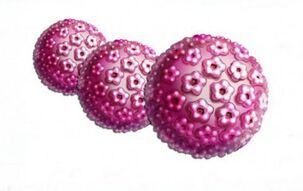
Papilloma virus can stay in the human body for a long time and cannot manifest itself in any way. It is only activated when the immune system is weakened. In most cases, the infection does not pose a particular threat, but certain strains may progress to oncological diseases under certain factors. And that is already a threat to human life. It is impossible to get rid of the pathogenic microorganism completely. Therefore, it is very important to know how the human papillomavirus spreads to reduce the risk of HPV infection.
Virus and its characteristics
Human papillomavirus causes the development of benign tumors on the skin and mucous membranes. They look like a papilla protruding several millimeters above the surface. As a general rule, such an increase occurs when the body’s defenses are weakened. Usually, one lives quietly and doesn’t even think about “I can be a carrier or not” yet. Why papillomas develop:
- frequent hypothermia or overheating;
- presence of concomitant diseases;
- malnutrition;
- presence of bad habits;
- common stress, depression, overload;
- Lack of vitamins, minerals and other nutrients.
90% of the world's population carries the papillomavirus. The question immediately arises as to whether or not the human papillomavirus is contagious. The answer is yes. No one is 100% insured against infection. Therefore, it is very important to know how you can become infected with HPV (human papillomavirus).
How the human papillomavirus spreads
Given that the likelihood of HPV infection is very high, the question often arises as to how the infection (human papillomavirus) spreads. Knowing the answer to this question can significantly reduce the risk of infection. Pathogenic microorganisms spread from person to person. These are the most common routes of infection. Contact methods for infection:
- Sexually transmitted HPV (sexually transmitted). Very often, the spread of an oncogenic microorganism occurs in this way. For example, HPV 16 and 18, for example, strains of types 16 and 18 are life-threatening because they can degenerate into oncological diseases.
- Contact methods of infection. It can infect a person by touching, hugging, kissing. The virus enters the body through damage, through microcracks in the skin. Therefore, you do not need to be in close contact with people if you notice a wart on your body (if you doubt it is contagious).
Transmission routes can be domestic. How to get an infection (papilloma) this way:

- through personal care products (towels, dishcloths, toothbrushes, etc. );
- human papillomavirus can spread through clothing (infection occurs through skin lesions);
- infection can occur in public baths, saunas (the pathogen can be on the floor, benches, etc. ).
The disease is not inherited. However, a newborn can become infected. How can a baby get papilloma:
- during intrauterine development of an infected mother;
- through the birth canal at birth.
Pregnant women should be very careful to avoid infecting or activating pathogens.After all, it is not only their health that depends on it, but also the life of the baby.
How human papilloma (HPV) spreads: Infection can occur in medical centers, hair salons, beauty salons due to insufficient sterilization of instruments. This is extremely rare because such institutions generally meet all health standards, but there is still a place to be.
The infected person doesn't even know about it. Therefore, it is recommended that routine diagnostic tests be performed annually. The way the infection developed has now become clear. This allows preventive measures to be taken and infection to be avoided.
Sexual Method
We previously figured out how to infect a benign tumor (papillomavirus). It has become clear that HPV most commonly spreads through intimacy (sexually). Moreover, it can be infected with all kinds of sexual (vaginal, oral, anal).Papilloma spreads through intimate (sexual) contact with contact with mucous membranes when damaged.Moreover, anal sex has a higher risk of infection because it is more traumatic.

Considering that the risk of infection increases during an intimate relationship, the question arises as to whether it is possible to have sex with HPV if a partner has it. Moreover, infection with oncogenic strains of the virus often occurs during sexual intercourse.
Sex with HPV is acceptable. But always use contraceptive contraception (a condom). According to statistics, protection helps prevent infection in men and women in 2 out of 3 cases. Without contraception, the risk of infection increases to 90%. If one of the people entering intimacy is infected, a regular diagnostic test for the oncogenicity of the pathogen (a healthy partner for the presence of HPV) should be performed.
However, during intercourse, even with contraception, side effects can occur. Growth can be damaged during sex. As a result, another infection or sepsis may occur in the wound. In addition, damage to the neoplasm may degenerate into malignancy. Thus, it turned out thathaving sex while treating HPV was not desirable.If so, be very careful. But it is still better to have a relationship only after treatment. Sex life after papillomas is less risky.
It is believed that the papillomavirus can be activated by masturbation. It is said to be an inappropriate intercourse that results in hormonal disorders and a weakened immune system. This opinion is wrong. Masturbation does not affect the body's defense functions in any way.
for oral sex
HPV can spread from woman to man and vice versa through oral sex. This is done through micro-damage to the skin and mucous membranes. Through oral sex, HPV strains are most commonly spread, which can progress to cancer.
A condom for oral sex only reduces the risk of infection if blowing work is done. Cunnilingus cannot be avoided in 90% of cases.
Does the human papillomavirus spread from mother to child?
How adults are most commonly infected with the papillomavirus has been figured out. It is now necessary to understand whether the human papillomavirus is passed from mother to child, how it happens, and what the risks are to babies.
In a newborn baby, the infection can occur by touching and kissing the mother if it is a carrier of the pathogenic microorganism. The infection enters the baby's body through damage to the skin or mucous membranes.
Infection can also occur during fetal development. From an infected woman to her fetus. Infection can also occur during birth. Although rare, it has serious consequences.

Through kissing and blood
How human papillomavirus infection spreads:
- via saliva;
- through a kiss;
- through blood.
The question immediately arises, if HPV is spread by kissing, can you kiss an infected person? This decision is up to you. If you are 100% sure that there is no damage to the oral cavity (even microscopic), then kissing is perfectly acceptable. However, this is a rather risky decision. There may be changes in your mouth that are not noticeable and of which you are not even aware.
The possibility of human papillomavirus being infected by blood has not been scientifically proven. There have been cases of infection during transfusion.However, this does not prove that the pathogen can spread in this way.In these cases, the infection was probably due to poorly sterilized devices.
Household Path
In 85-90% of cases, it can also be transmitted through the household if one of the family members becomes infected. Home pathogenic microorganisms very often spread from parents to children. The child’s immunity is still fragile, making the baby more prone to infections. A home infection can occur as follows:
Home pathogenic microorganisms very often spread from parents to children. The child’s immunity is still fragile, making the baby more prone to infections. A home infection can occur as follows:
- if the skin is damaged, infection can occur through shared bedding, towels, dishcloth, soap, cosmetics and hugs;
- can be transmitted through saliva if you use a dish, a toothbrush, to kiss the carrier of the virus;
- when wearing the clothing (especially underwear) of an infected person;
- Shaving and self-infection during epilation may occur in a domestic environment.
Infection in public places is also a common way for the pathogen to spread. For example, in the pool, steam bath, sauna. And also with frequent handshakes and friendly hugs.
How not to get infected with papillomavirus
How to get HPV (human papillomavirus):
- Avoid frequent exchanges of sexual partners;
- defend themselves during intimacy;
- Don't use other people's things;
- do not wear the clothes of others;
- Avoid visiting public baths, saunas, swimming pools (or at least bring private towels, replaceable shoes);
- do not drink or consume food from those infected;
- Carefully approach the choice of cosmetology, clinic and hairdresser (you must be sure that all sterilization rules are followed in the institution);
- Do not get in close contact with virus carriers.
If you develop papillomas, see your doctor. He performs the necessary diagnostics, determines the strain of the pathogen, and prescribes effective treatment if necessary.
Protects your condom
If one of the partners has HPV, a condom should be used during sexual intercourse. However, contraception is not a 100% guarantee that the infection will not spread. Of course, the pathogenwill not be able to break through the condom, but the infection can occur in other ways.
Foreplay can lead to infection. Through microcracks in the skin or mouth. In this case, the contraceptive contraceptive will not save you.
Treatment Methods
If you are a carrier of HPV, the infection can dormant in your body and not cause a problem.You need to monitor the condition of your immune system to prevent your body from growing.The stronger the neoplasm, the lower the risk of developing a neoplasm.
In case of growths, your doctor may advise you not to take any action (provided that the papillomas do not cause discomfort and do not have an oncogenic strain). If they have decided to get rid of neoplasms, this is usually done by conservative methods. If medication does not produce a therapeutic result or there is a risk that the papilloma may degenerate into an oncological disease, surgery is prescribed (unless there are contraindications).























